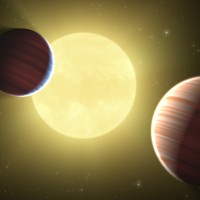Exoplanet & Brown Dwarf Surveys

Overview
Penn State researchers employ a variety of techniques to search for exoplanets and brown dwarfs, including the Doppler, transit, and direct imaging. Of these techniques, astronomers can only “see” a planet with the direct imaging technique. This method is best suited for discovering brown dwarfs, young planets orbiting far from their host star, and perhaps rogue planets speeding away from their host star. Most exoplanet detections are via indirect methods. In the transit method, astronomers measure the brightness of many stars to detect slight dimming of the star passes in front of the star and casts its shadow our telescopes. Using the transit method and NASA’s Kepler mission, astronomers have discovered of planets, mostly orbiting close to their host star and with sizes between that of Earth and Neptune. Using the Doppler method, astronomers make precise measurements of the velocities of stars to discover planets and characterizes their masses and orbits. So far, the Doppler method has discovered mostly giant planets, with masses similar to Saturn or Jupiter. Penn State faculty and students are leaders in developing instruments and conducting observational campaigns to extend the Doppler technique to reach planets more similar to Earth. In particular, the Hobby-Eberly Telescope was upgraded to have an improved high-resolution optical spectrograph and Penn State built the Habitable Zone Planet Finder, a new infrared spectrograph at HET. Penn State also built the NEID spectrograph currently conducting an Extremely Precise Radial Velocity Surveys at the WIYN 3.5m Observatory. Additionally, Penn State is a partner in the Minerva observatory to search for low-mass planets using intensive high-precision Doppler observations of bright stars.
Areas of Expertise
- Optical/IR surveys for brown dwarfs (Luhman)
- Doppler planet surveys (Ford, Mahadevan, Wright)
- Transit surveys (Feigelson, Ford)
- Multiple planet systems (Ford, Wright)
Faculty Contacts
- Eric Feigelson uses autoregressive statistical models to reduce stellar activity noise and improve the detection of planetary transit signals in the NASA Kepler mission dataset.
- Eric Ford characterizes the architectures of planetary systems in collaboration with multiple planet survey teams. Ford is collaborating with advisees and statisticans to apply machine learning algorithms to develop improved stellar activity indicators and algorithms for distinguishing stellar activity and planets.
- Kevin Luhman uses optical and infrared telescopes, including the James Webb Space Telescope, to search for free-floating brown dwarfs in the solar neighborhood and nearby star-forming regions, particularly those with the coldest temperatures and smallest masses.
- Suvrath Mahadevan is the PI for the Habitable Zone Planet Finder and NEID projects and is also the leader of a project using the APOGEE spectrograph to observe planet host stars identified by NASA’s Kepler mission.
- Don Schneider contributes to the Sloan Digital Sky Survey, including the MARVELS and APOGEE projects that perform multi-object spectroscopy.
- Jason Wright conducts high-precision Doppler measurements of stars to discover and characterize the masses and orbits of planets orbiting them. Prof. Wright’s group observes with the 10m Keck Observatory in collaboration with the California Planet Survey, and is planning upcoming Doppler planet surveys using the upgraded Hobby-Eberly Telescope (HET) and MINERVA observatories.




